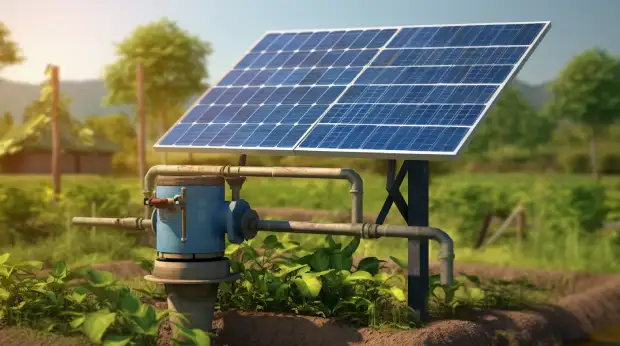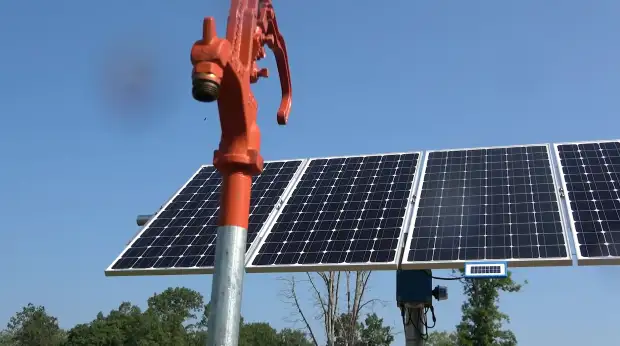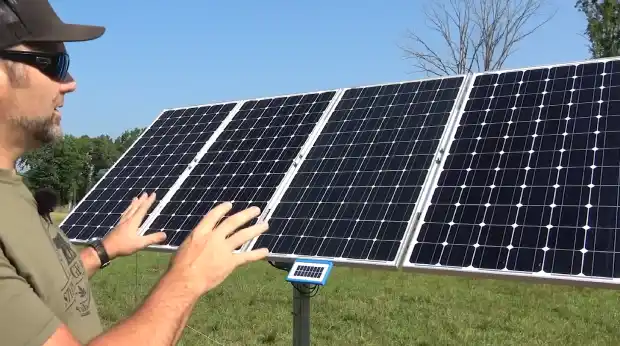When you set your well pump in a remote location or encounter utility outages, the question of whether you can run it on solar power arises.
Your well pump can run on solar energy. Running a well pump on solar energy is not only feasible but also a sustainable and eco-friendly solution. By harnessing the power of the sun, you can power your well pump and ensure a continuous water supply, even in off-grid areas.
Several factors need to be considered to accomplish this, including the type of pump, its power requirements, and the number of solar panels required.
We will share valuable insights on running your well pump efficiently with solar energy, enabling you to enjoy a reliable water source without relying on the conventional power grid.
How to Run a Well Pump on Solar?

The following steps will guide you through the process of running your well pump using a solar panel:
- Step 1: Select a Suitable Location
- Step 2: Mount the Solar Panels
- Step 3: Wire the Solar Panels
- Step 4: Connect the Well Pump
- Step 5: Add Backup Options
Let’s discuss the steps in detail to run your well pump effectively on solar power.
Step 1: Select a Suitable Location
To ensure the maximum efficiency of your solar-powered well pump, you need to select a location with maximum sunlight throughout the day and free from shading.
Ideally, the panels should be installed facing south and tilted at an angle that corresponds with the latitude of your area. This will ensure that they receive direct sunlight throughout the day.
Consider using a tracking system to improve panel efficiency in case your location receives irregular sunlight. With a tracking system, your panels will automatically move to follow the sun’s path.
Step 2: Mount the Solar Panels
When mounting your solar panels, use a sturdy and angled structure facing the sun. This will maximize the amount of energy that your panels collect.
Follow the manufacturer’s guidelines for properly mounting the panels and use the appropriate fasteners to secure them tightly in place. A wall-mounted panel will generate more energy than one that needs to be better installed.
Step 3: Wire the Solar Panels
You can connect the solar panels in a series or parallel configuration to achieve the desired voltage and current for your solar-powered well pump system.
Use appropriate solar panel cables and MC4 connectors to join the panels securely. Double-check the total voltage and current ratings before connecting the panels to the charge controller. Running solar panel cables from the panels to the charge controller will ensure an efficient flow of electricity.
Step 4: Connect the Well Pump
To power your well pump using solar energy, consider using either indirect or direct solar power consumption. The indirect method involves using an inverter to convert DC power from the solar panels to AC power for the existing AC pump.
This is a cost-effective solution with less installation complexity. The direct method involves using a DC well pump that runs directly on the DC power generated by the solar panels. This option provides higher efficiency but can be more expensive.
To ensure efficient use of power, a pump controller should be installed to manage the power supply to the pump.
Step 5: Add Backup Options
Install solar batteries to store excess energy from the solar panels. These batteries will provide backup power during low sunlight or power outages, ensuring a continuous water supply.
To get started, choose the appropriate solar batteries that match your system’s voltage and capacity requirements, such as lead-acid, lithium-ion, or saltwater batteries. Locate a suitable area for the battery installation, ensuring proper ventilation and avoiding direct sunlight and extreme temperatures to maintain optimal battery performance and lifespan.
Before installing the batteries, ensure the solar charge controller is connected to the solar panels to regulate the energy flow.
Wire the batteries in a battery bank, connecting the positive terminal of one battery to the positive terminal of the next and doing the same for the negative terminals, creating a series connection to increase the voltage while maintaining capacity.
Connect the battery bank to the charge controller, wiring the positive terminal of the battery bank to the positive input of the charge controller and the negative terminal likewise. Ensure secure connections and use appropriate cable sizes for efficient energy transfer.
Factors to Consider Before Running a Well Pump on Solar

When considering running a well pump on solar power, there are several factors to take into account. Among them are:
- Pump type
- Pump power
- Solar panel sizing
- Mounting options
- Additional panels
- Grounding
Let’s examine the factors that affect the efficiency of running a well pump on solar power in detail.
1. Pump Type
You need to choose the appropriate pump type based on your needs and location. Different types of well pumps are available, such as submersible, jet, and centrifugal pumps.
Among these, DC submersible pumps are often preferred for off-grid power use due to their higher efficiency and the ability to work directly with solar panels without the need for an inverter.
2. Pump Power
Consider the pump’s rated horsepower (HP), as it directly influences the number of solar panels needed to meet power demand.
To determine the number of solar panels needed for your system, consider the rated horsepower of the pump. The rated horsepower (HP) directly influences the power demand of the pump, which in turn affects the number of solar panels required for operation.
Higher horsepower pumps typically have higher power demands, meaning more solar panels are needed to meet that demand.
You need to accurately calculate the power requirements of your pump to ensure that your solar system can adequately power it. Consult the pump’s specifications or contact the manufacturer for information regarding power consumption.
3. Solar Panel Sizing
Determining the size of your solar panels depends on the power demand of your pump and the availability of sunlight in your location.
To effectively power a well pump with solar energy, you need to consider the wattage of the pump and the amount of sunlight your location receives.
You need to determine the power demand of your pump. It’s usually in the pump’s specs, or you can contact the manufacturer. Once you have this information, you can calculate the wattage required to run the pump effectively.
After that, you need to assess the sunlight availability in your location. The amount of sunlight your solar panels can receive directly affects their efficiency. Factors such as the panels’ shading, direction, and tilt angle can impact their performance.
Based on your pump’s power demand and the sunlight availability in your location, you can then determine the number and wattage of solar panels required to power the pump effectively.
4. Mounting Options
Consider the appropriate mounting options for your solar panels to ensure a secure and efficient installation. In terms of mounting your panels, you have several options based on your installation site.
Wall mounts are a popular choice if you have a sturdy wall available. These mounts allow you to attach the panels directly to the wall, saving space and providing easy access for maintenance.
Roof mounts are another common option, allowing you to install solar panels for maximum sunlight exposure.
If you don’t have a suitable wall or roof, you can opt for aluminum mounts on a pole or frame. These mounts provide flexibility in terms of positioning and can be adjusted to optimize the panel’s angle.
Consider the pros and cons of each option and choose the one that best suits your site and needs.
| Mounting Option | Pros | Cons |
| Wall Mounts | Space-saving, easy access for maintenance | Requires a sturdy wall |
| Roof Mounts | Maximum sunlight exposure | May require professional installation |
| Aluminum Mounts on a Pole or Frame | Flexibility in positioning, adjustable angle | Requires additional space and may need extra support |
5. Additional Panels
If you want to increase energy production during low-light periods or winter months, adding extra panels later’s a good idea.
By installing additional solar panels, you can maximize the power output of your system and ensure a reliable supply of electricity for running your well pump.
These extra panels will capture more sunlight and convert it into usable energy, allowing your pump to function efficiently even in less favorable conditions.
The added panels will provide a boost to your overall energy production, helping to meet the increased demand during periods of reduced sunlight or colder weather.
It is important to carefully consider the placement and installation of the additional panels to optimize their performance and ensure they are properly integrated into your existing solar system.
6. Grounding
Proper grounding procedures are crucial to ensure safety when using solar panels. Grounding helps protect against electrical shocks and minimizes the risk of fire hazards.
When installing solar panels for a well pump, following the grounding guidelines provided in the user manual is essential. Here are some key points to consider:
- Ensure all grounding connections are securely tightened.
- Use appropriate grounding materials, such as copper rods or grounding plates.
- Maintain proper spacing between grounding components to prevent interference.
- Regularly inspect and maintain the integrity of grounding connections.
- Consult a professional electrician if you need clarification on the grounding requirements for your specific setup.
How many solar panels will it take to run a well pump?

The number of solar panels needed to run a well pump depends on the pump’s horsepower (HP). RPS systems offer a range of solar pump kits designed to meet various power demands.
For instance, a 1/2 HP pump may only require two 100W solar panels, while a more substantial 5 HP pump may need around 20 solar panels.
The wattage capacity of the solar panels ensures a sufficient energy supply to meet the power demands of the well pump, providing an efficient and eco-friendly solution for water supply in off-grid or remote locations.
How deep can a solar well pump go?
A solar well pump can typically be submerged to a depth of about 400 feet, which refers to the total pump head. However, it’s essential to consider the specific characteristics of your well.
If your well has a shallow static water level (the distance from the top of the water to the surface) but a deeper overall depth, you may need to place the pump slightly higher in the well.
Understanding your well’s depth and water level is crucial in determining the appropriate placement of the solar pump for efficient water extraction.
Harness Solar Energy for Your Well Pump Today
So, now you clearly understand how to run a well pump using the energy of solar power efficiently. Selecting the right pump type, properly sizing your solar panels, and mounting them in the optimal location will maximize your system’s efficiency.
You can ensure a reliable and eco-friendly water supply even in remote areas by considering factors like pump type, power requirements, solar panel sizing, mounting options, additional panels, and grounding.
Adding backup options like solar batteries will ensure an uninterrupted water supply during low sunlight or power outages.
With this knowledge, you can confidently harness the sun’s power to run your well pump sustainably and enjoy a continuous water source while reducing your carbon footprint.


